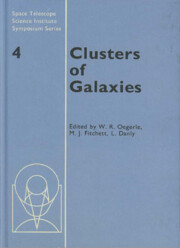Book contents
- Frontmatter
- Contents
- Preface
- Participants
- Chapter 1 Cosmology and Cluster Formation
- Chapter 2 Clusters of Galaxies: Structure, Infall, and Large-Scale Distribution
- Chapter 3 Cosmogony with Clusters of Galaxies
- Chapter 4 Cosmogony and the Structure of Rich Clusters of Galaxies
- Chapter 5 The Dark Matter Distribution in Clusters
- Chapter 6 The Effect of the Cluster Environment on Galaxies
- Chapter 7 Evidence for Gas Deficiency in Cluster Galaxies
- Chapter 8 Properties of Galaxies in Groups and Clusters
- Chapter 9 Dynamical Evolution of Clusters of Galaxies
- Chapter 10 Hot Gas in Clusters of Galaxies
- Chapter 11 Hydrodynamic Simulations of the Intracluster Medium
- Chapter 12 Evolution of Clusters in the Hierarchical Scenario
- Chapter 13 Distant Clusters as Cosmological Laboratories
- Chapter 14 Future Key Optical Observations of Galaxy Clusters
- Chapter 15 Cluster Research with X-ray Observations
- Plate section
Chapter 9 - Dynamical Evolution of Clusters of Galaxies
Published online by Cambridge University Press: 06 July 2010
- Frontmatter
- Contents
- Preface
- Participants
- Chapter 1 Cosmology and Cluster Formation
- Chapter 2 Clusters of Galaxies: Structure, Infall, and Large-Scale Distribution
- Chapter 3 Cosmogony with Clusters of Galaxies
- Chapter 4 Cosmogony and the Structure of Rich Clusters of Galaxies
- Chapter 5 The Dark Matter Distribution in Clusters
- Chapter 6 The Effect of the Cluster Environment on Galaxies
- Chapter 7 Evidence for Gas Deficiency in Cluster Galaxies
- Chapter 8 Properties of Galaxies in Groups and Clusters
- Chapter 9 Dynamical Evolution of Clusters of Galaxies
- Chapter 10 Hot Gas in Clusters of Galaxies
- Chapter 11 Hydrodynamic Simulations of the Intracluster Medium
- Chapter 12 Evolution of Clusters in the Hierarchical Scenario
- Chapter 13 Distant Clusters as Cosmological Laboratories
- Chapter 14 Future Key Optical Observations of Galaxy Clusters
- Chapter 15 Cluster Research with X-ray Observations
- Plate section
Summary
Abstract. Recent progress in understanding four processes that play a large role in the evolution of clusters of galaxies is reviewed. These are dynamical friction, mergers, collisional tidal stripping and the cluster mean field tide. Recent estimates for the growth rate of the cD galaxy and its frequency of appearance are discussed. In spherical relaxed clusters the theoretical and observational results for the accretion rate of a central massive galaxy seem to be quite consistent. It appears that a major part of the cD formation must occur in subclusters. Recent work on the formation of clusters containing galaxies and dark matter suggests that considerable mass segregation occurs in small subclusters (provided clusters form in a bottom up manner). This appears to be a result of dynamical friction. It may imply that visible clusters are embedded in large dark matter halos and that cluster M/L's have been underestimated.
INTRODUCTION
Clusters of galaxies represent a fascinating, if formidable, challenge for the theorist. Although relatively young in terms of their crossing times (Tcr = R/v), the galaxies are sufficiently large and massive that they interact with each other and the intracluster medium on a timescale comparable to their ages. A sensible way to organize a report on this complicated subject is, by analogy with stellar structure, to report first on the detailed processes which may occur (the ‘hydrodyamics’ and atomic ‘physics’ of the problem) and then to examine the effects of these processes (the analog of ‘evolution’) on the galaxies and the cluster.
- Type
- Chapter
- Information
- Clusters of Galaxies , pp. 231 - 256Publisher: Cambridge University PressPrint publication year: 1990
- 6
- Cited by

